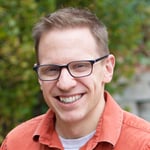Turning Vanity Metrics Into Actionable Marketing Metrics
Written by

The data you can gather from inbound marketing campaigns is, in a word, remarkable. You have a plethora of marketing analytics at your disposal any time someone visits a page on your site, downloads content, subscribes to your blog, opens an email, watches a video, interacts with you on social media...the list goes on and on.
In the mess of all that beautiful data, however, it’s not always obvious which metrics provide real, actionable insights, and which just paint a general picture. Are you relying on truly valuable marketing metrics or vanity metrics to reach your business goals?
What are Vanity Metrics?
Vanity metrics are data points that have no real value to your business because they don’t provide any actionable steps to improve your marketing and sales strategy.
There are certainly metrics that will make you and your boss feel good. It’s great to see growth month over month, after all — more website visitors, social followers, etc. Sure, you feel all fuzzy inside, but do you know anything about the quality of those visitors?
Are they even your target audience? Are they from relevant referrals or quick-to-bounce visitors from paid search? Are they even in your industry or target market or are they international visitors outside your geographic reach? Most importantly, what actionable steps to improve your marketing strategy do those numbers encourage you to take?
When the answers to all these questions leads to a big, fat, “Ummm… I dunno,” then you can be assured all those numbers are merely vanity metrics. Merriam–Webster probably describes “vanity” the best, which explains why it’s the perfect term to describe these kinds of metrics: something that is vain, empty, or valueless.
 SOURCE: Merriam–Webster
SOURCE: Merriam–Webster
Examples of Vanity Metrics
Some of the most popular vanity metrics that receive too much emphasis are traffic, page views, new followers, time on site, and even conversions or downloads. At face value, these are all good indicators of how well your site (or social media) is doing, and you shouldn’t feel bad for tracking these metrics. After all, Google Analytics and other marketing analytics tools make it impossible to miss these whenever you log in, and you definitely do want to see traffic growth, new followers, and visitors downloading your content.
That said, traffic alone does not tell the whole story. Perhaps your bounce rate is high, or your click-through rate is low. These factors determine your overall page performance and reveal visitors' habits on your pages. If you really want to glean information on what’s working and what isn’t — why your site spiked 5,000 visits last month, for example — you have to take a deeper look at what (and who) is driving those numbers.
Turning Vanity Metrics into Actionable Metrics
When you can dig into the data behind vanity metrics, you’ll find that there’s a lot of actionable information you can use to improve your website and content marketing. Information like where the traffic came from, what their conversion rate is, and how often they bounce from your page can be analyzed and used to help direct your marketing efforts. There are lots of tools for tracking meaningful metrics, but if you’re wondering which vanity metrics to start unpacking for deeper meaning, here are a few quick examples below:
Traffic → Sources
Everyone wants to see traffic growth on their sites. However, what you really want to know is what’s driving that traffic and where it’s coming from. If you notice a huge spike in traffic, find out if it came from a social media post going viral or being featured on another website. Maybe you just launched a weekly blog-in-review email marketing campaign that has been a huge success in driving additional traffic.
Whatever the case, analyzing the source of your website traffic will provide much more useful insights than simply tracking it’s growth month-by-month.
Average Time on Page → Bounce Rate
While the average time on page is a good indicator of how long visitors are staying on your site and its particular pages, it doesn’t tell you how many people are bouncing from your site altogether — which is an equally important metric when it comes to SEO.
If you notice a page has a particularly low time on page and high bounce rate, you need to look deeper to see why people are bouncing. Here are some potential causes:
- Does it have a long load time?
- Is it a confusing layout?
- Is there a problem with the link?
- Is the content inconsistent with the headline or meta description?
These are the things you can’t find out by simply looking at the time on page.
Conversions → Conversion Rate & Lead Quality
Let’s say you ran an ad last month on LinkedIn that generated a ton of traffic for your site and led to over 100 downloads of your new eBook. Sounds pretty successful, right?
Well, what if we told you the audience selection for the campaign was terrible, and the conversion rate on the content offer was less than 10%? The campaign ended up costing more than $10,000 to generate those numbers and, worse yet, 90% of the leads came from a foreign country or used fake information on the download form. The cost per lead is unacceptable, especially when those leads aren’t even worth handing over to your sales team. Still happy with those vanity metrics?
Even if you get a large number of downloads, it’s important to assess how the download was accessed. Was it gated or was the download made available with the click of a button? When it comes to analyzing the success of your campaigns and content, metrics like conversion rate and lead quality are much more important than the total number of downloads. Lead generation and lead quality are not one and the same.
Social Followers → Engaged Audience
Too often, companies view the number of social followers as an indication of their success or failure on social media.
It’s time to look past the number of followers you have and focus on what matters: delivering helpful advice and relevant content. The number of engaged and active users are far more important than the raw number of followers, especially for B2B customers. You also want that quality content to be viewed at the right time. HubSpot and other marketing automation software have features that allow you to schedule posts in advance, so you can time your posts with your campaigns.
By focusing your efforts on the followers you do have, you can share content that will engage them. And setting standards for how much you promote your content should absolutely be part of your plan.
RELATED: Inspiring Employee Support For Your Social Media Marketing Strategy
Definition of an Actionable Metric
If a vanity metric is a metric that doesn’t show the true impact or provide deep enough insights to help drive change, an actionable metric could be defined as any metric in which its context can be used to help make an impactful change to your marketing.
For example, 100,000 new visitors to your website means nothing if they all bounce from your page within 5 seconds. By focusing on the bounce rate instead of overall traffic, you’ll analyze the different reasons people are bouncing from your site and make the necessary adjustments to resolve those issues. That’s what separates a vanity metric from a real, actionable metric.
Furthermore, actionable metrics are precise and help assess progress, as the context it provides helps establish attainable goals and objectives. For example, you can’t set a realistic conversion goal for your new content offer if you don’t know the typical conversion rate of your landing pages. You need a baseline.
At the end of the day, your metrics aren’t there to make you feel good about your website; they’re there to make you think, help you improve, and find ways to grow your business. There are hundreds of different data points you can use to analyze your inbound marketing program, from social media, website traffic, user experience, and much more. Instead of wasting time on what doesn’t matter (because what marketer has time to spare?), take advantage of useful metrics to improve your website and other marketing efforts.
Just as important as identifying insights from your metrics is demonstrating ROI. Our ebook, Marketing Metrics Your Boss Cares About helps you do just that. Click the link to get your copy.
Subscribe To Our Blog
Information. Insights. Ideas. Get notified every time a new Weidert Group blog article is published – subscribe now!
You May Also Like...

Search Engine Optimization
Optimize Your Industrial Website for AI Search

Marketing Technology
Why Unified Data Efforts Fail (and How Manufacturers Can Fix It)

Search Engine Optimization
How Falcon Rebuilt Industrial AI Search Visibility in 2025
Accelerate Your Growth with
Weidert Group
If you’re ready to explore a partnership, request a personalized consultation with our team.






